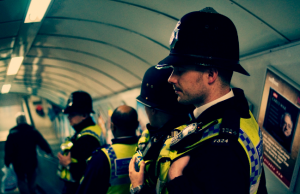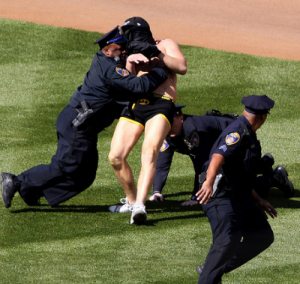I was going to write about something else today (the finding from a meta-analysis that artificial surveillance cues do not appear to appreciably increase generosity; the effects fail to reliably replicate), but I decided to switch topics up to something more topical: police violence. My goal today is not to provide answers to this on-going public debate – I certainly don’t know enough about the topic to consider myself an expert – but rather to try and add some clarity to certain features of the discussions surrounding the matter, and hopefully help people think about it in somewhat unusual ways. If you expect me to take a specific stance on the issue, be that one that agrees or disagrees with your own, I’m going to disappoint you. That alone may upset some people who take anything other than definite agreement as a sign of aggression against them, but there isn’t much to do about that. That said, the discussion about police violence itself is a large and complex one, the scope of which far exceeds the length constraints of my usual posts. Accordingly, I wanted to limit my thoughts on the matter to two main domains: important questions worth answering, and addressing the matter of why many people find the “Black Lives Matter” hashtag needlessly divisive.
First, let’s jump into the matter of important questions. One of the questions I’ve never seen explicitly raised in the context of these discussions – let alone answered – is the following: How many people should we expect to get killed by police each year? There is a gut response that many would no doubt have to that question: zero. Surely someone getting killed is a tragedy that we should seek to avoid at all times, regardless of the situation; at best, it’s a regrettable state of affairs that sometimes occurs because the alternative is worse. While zero might be the ideal world outcome, this question is asking more about the world that we find ourselves in now. Even if you don’t particularly like the expectation that police will kill people from time to time, we need to have some expectation of just how often it will happen to put the violence in context. These killings, of course, include a variety of scenarios: there are those in which the police justifiably kill someone (usually in defense of themselves or others), those cases where the police mistakenly kill someone (usually when an error of judgment occurs regarding the need for defense, such as when someone has a toy gun), and those cases where police maliciously kill someone (the killing is aggressive, rather than defensive, in nature). How are we to go about generating these expectations?
One popular method seems to be comparisons of police shootings cross-nationally. The picture that results from such analyses appears to suggest that US police shoot people much more frequently than police from other modern countries. For instance, The Guardian claims that Canadian police shoot and kill about 25 people a year, as compared with approximately 1,000 such shootings in the US in 2015. Assuming those numbers are correct, once we correct for population size (the US is about ten-times more populated than Canada), we can see that US police shoot and kill about four-times as many people. That sure seems like a lot, probably because it is a lot. We want to do more than note that there is a difference, however; we want to see whether that difference violates our expectations, and to do that, we need to be clear about why our expectations were generated. If, for example, police in the US face threatening situations more often than Canadian police, this is a relevant piece of information.
To begin engaging with that idea, we might consider how many police die each year in the line of duty, cross-nationally as well. In Canada, the number for 2015 looks to be three; adjusting for population size again, we would generate an expectation of 30 US police officer deaths if all else were equal. All else is apparently not equal, however, as the actual number for 2015 in the US is about 130. Not only are the US police killing four-times as often as their Canadian counterparts, then, but they’re also dying at approximately the same rate as well. That said, those numbers include factors other than homicides, and so that too should be taken into account when generating our expectations (in Canada, the number of police shot was 2 in 2015, compared to 40 in the US, which is still twice as high as one would expect from population size
. There are also other methods of killing police, such as the 50 US police killed by bombs or cars; 0 for Canada). Given the prevalence of firearm ownership in the US, it might not be too surprising that the rates of violence between police and citizens – as well as between citizens and other citizens – looks substantially different than in other countries. There are other facts which might adjust our expectations up or down. For instance, while the US has 10 times the population of Canada, the number of police per 100,000 people (376) is different than that of Canada (202). How we should adjust the numbers to make a comparison based on population differences, then, is a matter worth thinking about (should we expect ratio of police officers to citizens per se to increase the number of them that are shot, or is population the better metric?). Also worth mentioning is that the general homicide rate per 100,000 people is quite a bit higher in the US (3.9) than in Canada (1.4). While this list of considerations is very clearly not exhaustive, I hope it generates some thoughts regarding the importance of figuring out what our expectations are, as well as why. The numbers of shootings alone are going to be useless without good context. 
Factor 10: Perceived silliness of uniforms
The second question concerns bias within these shootings in the US. In addition to our expectations for the number of people being killed each year by police, we also want to generate some expectations for the demographics of those who are shot: what should we expect the demographics of those being killed by police to be? Before we can claim there is a bias in the shooting data, we need to both have a sense for what our expectation in that regard are, why they are such, and only then can we look at how those expectations are violated.
The obvious benchmark that many people would begin would be the demographics of the US as a whole. We might expect, for instance, that the victims of police violence in the US are 63% white, 12% black, about 50% male, and so on, mirroring the population of the country. Some data I’ve come across suggests that this is not the case, however, with approximately 50% of the victims being white and 26% being black. Now that we know the demographics don’t match up as we’d expect from population alone, we want to know why. One tempting answer that many people fall back on is that police are racially motivated: after all, if black people make up 12% of the population but represent 26% of police killings, this might mean police specifically target black suspects. Then again, males make up about 50% of the population but represent about 96% of police killings. While one could similarly posit that police have a wide-spread hatred of men and seek to harm them, that seems unlikely. A better explanation for more of the variation is that men are behaving differently than women: less compliant, more aggressive, or something along those lines. After all, the only reasons you’d expect police shootings to match population demographics perfectly would be either if police shot people at random (they don’t) or police shot people based on some nonrandom factors that did not differ between groups of people (which also seems unlikely).
One such factor that we might use to adjust our expectations would be crime rates in general; perhaps violent crime in particular, as that class likely generates a greater need for officers to defend themselves. In that respect, men tend to commit much more crime than women, which likely begins to explain why men are also shot by police more often. Along those lines, there are also rather stark differences between racial groups when it comes to involvement in criminal activity: while 12% of the US population is black, approximately 40% of the prison population is, suggesting differences in patterns of offending. While some might claim that prison percentage too is due to racial discrimination against blacks, the arrest records tend to agree with victim reports, suggesting a real differential involvement in criminal activity.
That said, criminal activity per se shouldn’t get one shot by police. When generating our expectations, we also might want to consider factors such as whether people resist arrest or otherwise threaten the officers in some way. In testing theories of racial biases, we would want to consider whether officers of different races are more or less likely to shoot citizens of various demographics (that is to ask whether, say, black officers are any more or less likely to shoot black civilians than white officers are. I could have sworn I’ve seen data on that before but cannot appear to locate it at this time. What I did find, however, was a case-matched study of NYPD officers, reporting that black officers were about three times as likely to discharge their weapon as white officers at the scene, spanning 106 shooting and about 300 officers; Ridgeway, 2016). Again, while this is not a comprehensive list of things to think about, factors like these should help us generate our expectations about what the demographics of police shooting victims should look like, and it is only from there that we can begin to make claims about racial biases in the data. 
It’s hard to be surprised at the outcomes sometimes
Regardless of where you settled on your answer to the above expectations, I suspect that many people would nonetheless want to reduce those numbers, if possible. Fewer people getting killed by police is a good thing most of the time. So how do we want to go about seeing that outcome achieved? Some have harnessed the “Black Lives Matter” (BLM) hashtag and suggest that police (and other) violence should be addressed via a focus on, and reductions in, explicit, and presumably implicit, racism (I think; finding an outline of the goals of the movement proves a bit difficult).
One common response to this hashtag has been the notion that BLM is needlessly divisive, suggesting instead that “All Lives Matter” (ALM) be used as a more appropriate description. In turn, the reply to ALM by BLM is that the lack of focus on black people is an attempt to turn a blind eye to problems viewed a disproportionately affecting black populations. The ALM idea was recently criticized by the writer Maddox, who compared the ALM expression to a person who, went confronted with the idea of “supporting the troops,” suggests that we should support all people (the latter being a notion that receives quite a bit of support, in fact). This line of argument is not unique to Maddox, of course, and I wanted to address that thought briefly to show why I don’t think it works particularly well here.
First, I would agree that “support the troops” slogan is met with a much lower degree of resistance than “black lives matter,” at least as far as I’ve seen. So why this differential response? As I see it, the reason this comparison breaks down involves the zero-sum nature of each issue: if you spend $5 to buy a “support the troops” ribbon magnet to attach to your car, that money is usually intended to be designated towards military-related causes. Now, importantly, money that is spent relieving the problems in the military domain cannot be spent elsewhere. That $5 cannot be given to both military causes and also given to cancer research and also given to teachers and also used to repave roads, and so on. There need to be trade-offs in whom you support in that case. However, if you want to address the problem of police violence against civilians, it seems that tactics which effectively reduce violence against black populations should also be able to reduce violence against non-black populations, such as use-of-force training or body cameras.
The problems, essentially, have a very high degree of overlap and, in terms of the raw numbers, many more non-black people are killed by police than black ones. If we can alleviate both at the same time with the same methods, focusing on one group seems needless. It is only those killings of civilians that effect black populations (24% of the shootings) and are also driven predominately or wholly by racism (an unknown percent of that 24%) that could be effectively addressed by a myopic focus on the race of the person being killed per se. I suspect that many people have independently figured that out – consciously or otherwise – and so dislike the specific attention drawn to race. While a focus on race might be useful for virtue signaling, I don’t think it will be very productive in actually reducing police violence. 
“Look at how high my horse is!”
To summarize, to meaningfully talk about police violence, we need to articulate our expectations about how much of it we should see, as well as its shape. It makes no sense to talk about how violence is biased against one group or another until those benchmarks have been established (this logic applies to all discussions of bias in data, regardless of topic). None of this is intended to be me telling you how much or what kind of violence to expect; I’m by no means in possession of the necessary expertise. Regardless, if one wants to reduce police violence, inclusive solutions are likely going to be superior to exclusive ones, as a large degree of overlap in causes likely exists between cases, and solving the problems of one group will help solve the problems of another. There is merit to addressing specific problems as well – as that overlap is certainly less than 100% – but in doing so, it is important to not lose sight of the commonalities and distance those who might otherwise be your allies.
References: Ridgeway, G. (2016). Officer risk factors associated with police shootings: a matched case-control study. Statistics & Public Policy, 3, 1-6.

